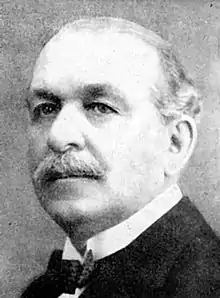Stelian Popescu
Stelian Popescu (February 18, 1874 in Lacu Turcului, Prahova County – 8 March 1954 in Madrid, Spain) was a nationalist Romanian journalist.[1]
Stelian Popescu | |
|---|---|
 | |
| Born | February 19, 1874 |
| Died | March 8, 1954 (aged 80) |
| Nationality | Romania |
| Occupation | Journalist, judge, politician |
.jpg.webp)
Biography
He was elected to Parliament many times. He was Minister of Justice in the Ionescu cabinet (December 17, 1921 – January 19, 1922), the Știrbey cabinet (June 4 – 20, 1927), the Seventh Ion I. C. Brătianu cabinet (June 22 – November 24, 1927) and the Vintilă I. C. Brătianu cabinet (November 24, 1927 – November 9, 1928).
Popescu ran the Universul newspaper from 1915 to 1945, transforming it into one of the most readable newspapers of the interwar period. Being a right-wing journalist, the newspaper remained influenced by this ideas, which attracted many adversities, especially from the social-democratic or socialist newspapers, such as the newspaper Adevărul. He criticized the governments of the time, came into conflict with King Carol II of Romania, and at the beginning of the 1940s he unconditionally supported Marshal Ion Antonescu.
On his initiative, between 1926 and 1930, the Universe Palace was built, the headquarters of the editorial and typography of the Universul newspaper.
In 1933, the "Anti-revisionist League" was founded in Romania, led by Popescu, a nationalist with an audience in Romania, who was fighting against Hungary's claims on Transylvania, in writing and in public events.[2] The activity of the Anti-revisionist League was banned by Carol II on March 7, 1939.
In 1944 Popescu took refuge in Switzerland, the newspaper's management remaining in the hands of one of his sons-in-law, Ion Lugosianu.[3]
After World War II, he was tried in absentia by the Bucharest People's Tribunal and sentenced on June 4, 1945 to life imprisonment. He was included in the "group of 14 journalists", along with, among others, Pamfil Șeicaru, Nichifor Crainic, and Radu Gyr. All were accused that "through newspaper articles, brochures or conferences, they were serving Fascist or Hitlerist propaganda or they contributed by their action to support a hateful regime and a bad foreign policy, a policy that had to have the consequences of Romania implication in a disastrous adventure and the political and military collapse of the country”.[4][5]
Before the war, his influence had become so great that his hometown was renamed "Stelian Popescu" by the Liberal government. Regarding this naming, Marta Breaban wrote the following in her journal:[6] “It was called Stelian Popescu because the director of the Universe newspaper at that time was born in this commune, his father being a priest here. In his native village, Stelian Popescu built the church, school, town hall and dispensary. The church was painted by the painter Norocea who followed the design of Curtea de Argeș.”
Popescu had a house in Bucharest, on Dionisie Lupu street (today Tudor Arghezi) no. 10 bis, built in 1911, that was built according to the design of architect Paul Smarandescu.[7]
Popescu also had a villa in Balchik, built in 1936 by the architect Henrieta Delavrancea-Gibory. The villa was demolished in 2009, because it was inclined due to the settlement of the land, and on that land a hotel was built.[8]
In 1933 Eustațiu Stoenescu painted the portrait of Popescu.[9]
The Student House of Culture in Bucharest, on Calea Plevnei, was built by public subscription of Popescu, who donated it to the University, on November 18, 1937, with the same destination that it has today.[10]
References
- Upson Clark, Charles (1971). United Romania. New York: Arno Press. pp. 305–306. ISBN 978-0405027413. Retrieved 2012-07-25.
- "Sfârșitul României Mari (1940)", archive.is, 19 July 2010, retrieved 29 April 2020
- "Jurnalismul interbelic (2) – Ziarul „Universul"", PoliteiaWorld, 17 June 2013, retrieved 29 April 2020
- "Istoria comunismului românesc: "Ziariștii fasciști", în boxa acuzaților", archive.is, 26 July 2014, retrieved 29 April 2020
- Stoica, Mihaela (May 30, 2020). "75 de ani de la procesul "ziariștilor fasciști, vinovați de dezastrul țării". Cum îi șantaja pe politicieni Pamfil Șeicaru". descopera.ro (in Romanian). Retrieved December 4, 2020.
- "Bucovina și școala Eraclide la București", archive.is, 31 October 2013, retrieved 29 April 2020
- "Casa Stelian Popescu, București, strada Dionisie, 1911 - Paul Smarandescu", archive.is, 18 September 2013, retrieved 29 April 2020
- "Vila Stelian Popescu - Wikimapia", Wikimapia.org, retrieved 29 April 2020
- "Muzeul de Artă din Craiova", archive.is, 18 September 2013, retrieved 29 April 2020
- Mitroi, Ștefan (November 14, 2012). "Elena Ceaușescu era înnebunită după cântecele Song-ului". jurnalul.ro. Retrieved December 4, 2020.